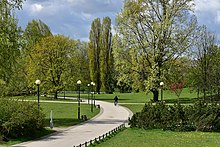| Mokotów Field | |
|---|---|
 Mokotów Field in autumn Mokotów Field in autumn | |
| Type | Municipal |
| Location | Warsaw |
| Coordinates | 52°12′39″N 21°00′00″E / 52.21083°N 21.00000°E / 52.21083; 21.00000 |
| Area | 73 hectares (180 acres) |
| Status | Open all year |
| Public transit access | |
Mokotów Field (Polish: Pole Mokotowskie) is a large park in Warsaw, Poland. A part of the parkland is called the Marshal Józef Piłsudski Park.
Located between Warsaw's Mokotów district and the city center, the park is one of the largest in Warsaw. Contrary to its name, only a small part of the modern Mokotów Field is located in the Mokotów district. Most of the field (48.61 ha, almost 71%) is located in Ochota and Śródmieście. Landmarks within the park include the Polish National Library and the Monument in Memory of the Fallen Polish Pilots in World War II. The park is also famous for its bars. To the south is a Warsaw Metro station, the Pole Mokotowskie station.
History

From 1818 until World War II, on what was originally a 200 ha area, a major part was occupied by an airfield and the Warsaw Polytechnic aircraft works. The Mokotów Field was also, until 1934, the site of Warsaw Airport and, in the years 1884-1939, of the Warsaw Horse Racing Track. On May 17, 1935, the funeral of Józef Piłsudski took place on the Mokotów Field.
The current park was designed by Stanisław Bolek and created in the 1970s and 1980s. In 2010, a two-kilometer educational trail was opened named after Ryszard Kapuściński. In 2018, near the intersection of al. Niepodległości and ul. Wawelska Street, 45 apple trees were planted to commemorate prominent Polish women.
Greater modernisation was initiated in 2021-2024. Concreted surfaces were reduced, a new water system with reed vegetation was created, and wooden platforms and bridges and wooden seats were added. New trees and flowerbeds were also planted.
Fauna

Twenty-one families of beetles are found in the park. Most of them are species from the ladybug family, of which the Asian ladybug is the most numerous, accounting for almost two-thirds of the individuals found. The next species, Aphidecta obliterata, accounted for 9.3%.
Due to the periodic lack of water in the ponds, there are no stable fish populations in the Mokotów Field, although some freshwater fish can be observed, such as individuals of the genus Xiphophorus.
See also
Notes
- ^ "Pole Mokotowskie | Zielona Warszawa". zielona.um.warszawa.pl. Retrieved 2021-06-06.
- ^ Jacek Tomczak - Janowski (November 11, 2002). "Historia Pól Mokotowskich". polamokotowskie.pl (in Polish). Retrieved 2008-02-18.
- "Wyborcza.pl". warszawa.wyborcza.pl. Retrieved 2021-06-06.
- "Wybitne Polki w parku Pole Mokotowskie | Warszawa - oficjalny portal stolicy Polski". www.um.warszawa.pl. Retrieved 2021-06-06.
- "Park Pole Mokotowskie w nowej odsłonie już otwarty! | Zarząd Zieleni m.st. Warszawy". Zarząd Zieleni m.st. Warszawy |. 2023-12-12. Retrieved 2024-09-04.
- Pstrokoński, P. (2017). "Przyroda Pola Mokotowskiego" Raport z realizacji Projektu w latach 2015–2017" (PDF) (in Polish). Warsaw. p. 29.
- Maciaszek, R. (2019). "Alien freshwater fish, Xiphophorus interspecies hybrid (Poeciliidae) found in artificial lake in Warsaw, Central Poland". World Scientific News (132): 291–299.
